Bio-Inspired Electricity Storage Alternatives to Support Massive Demand-Side Energy Generation: A Review of Applications at Building Scale
Abstract
:1. Introduction
- Charging period: the power grid is used during off-peak intervals when electric power is at a lower cost.
- Discharge period: at peak demand time, the stored energy is used. During this period, the grid has a higher cost, so the use of distributed generation makes it more economical. Consequently, storage systems are applied to reduce or eliminate the uncertainties of distributed generation.
- Large-scale storage (GW): reversible hydro (pumped), thermal storage.
- Grid and generation asset storage (MW): cells, batteries, condensers, superconductors, flywheels.
- End-user storage (kW): batteries, superconductors, flywheels.
2. Materials and Methods
3. Conventional Electricity Storage Strategies: Concept and Applications at Building Scale
3.1. Pumped-Hydro Energy Storage (PHES)
3.2. Compressed Air Energy Storage (CAES)
- With a pressure of 30 bar, the compressor absorbed 8702 kWh of excess PV energy in a 1.7 m3 vessel. Expanding through the turbine generated 1008 kWh in 38 min which covered 21.9% of the residential energy demand.
- At a pressure of 225 bar, 96% of the excess PV energy was absorbed within a 0.25 m3 enclosure. The expansion generated 1273 kWh, which covered 26% of the residential energy demand.
- Using the lead-acid battery with 80% charge efficiency was able to cover 100% of the total demand, which was equivalent to 4.6 kWh, demonstrating that, in terms of overall efficiency, the CAES system is less than any electrochemical battery system.
3.3. Flywheel Energy Storage System (FESS)
3.4. Battery Energy Storage System (BESS)
3.5. Supercapacitor Energy Storage System
- Electrochemical double-layer supercapacitors (EDLC): this electrochemical double-layer capacitor uses its two charge layers when a voltage is applied to an electrode (made of highly porous carbon) immersed in an electrolytic substance. Its slight charge separation generates capacitances on the order of 40–60 F/cm3. Unlike conventional capacitors, the energy required to enter the breakdown field is very high and is usually calculated in V/cm.
- Supercapacitors with pseudocapacitance: this type of supercapacitors store charges in a faradic form rather than electrostatical by means of a charge transfer between an electrode and an electrolyte. They can be composed of polymer materials or metal-oxide compounds and, therefore, have different costs, conductivity, pseudocapacitance, and application characteristics. A supercapacitor based on metal-oxide composites has a high energy storage density and therefore is very similar to EDLC capacitors.
- Hybrid supercapacitors: they are a mixture of EDLC supercapacitors together with pseudocapacitors since this system combines both faradic and non-faradic processes to store the charge. Currently, several tests have been carried out with different elements such as ruthenium dioxide (RuO2), cobalt oxide (Co3O4), nickel oxide (NiO), vanadium oxide (V2O5), nickel hydroxide (Ni(OH)2, and manganese oxide (MnO2), the latter having the best qualities since it is abundant and friendly material on Earth. This type of supercapacitor is widely used in battery systems to improve their efficiency.
3.6. Superconducting Magnetic Energy Storage (SMES)
3.7. Hydrogen Energy Storage
4. Bio-Inspired Electricity Storage Strategies
4.1. Energy Storage, Photosyntesis
4.2. Battery Electrode Materials
4.3. Energy Production, Anatomy of Plants
4.4. Energy Generation by Respiratory Reactions of Microorganisms
4.5. Thermoelectric and Thermoregulatory Properties of the Oriental Wasp (Vespa Orientalis)
4.6. Sucrose Modification of Li4Ti5O12 Anode Material for Lithium-Ion Batteries
4.7. Improvement of Microbial Cells for Electron Transfer
4.8. Bio-Electrocatalysis for the Production of Green Chemicals, Fuels, and Materials
| Pinnacle (Strategies) | Mechanism | Principle | Primary Characteristic | Ref. |
|---|---|---|---|---|
| Venus Flytraps It has leaves divided into two movable halves. Once the prey lands inside the open leaves, these halves close, imprisoning the prey inside the plant. | Confine the lignin within the electrode to prevent dissolution by acting as a current collector to provide electron transport during the electrochemical reaction. | Reconfigurable graphene cage to capture lignin. | Environmentally friendly battery electrode materials | 2017 [27] |
| Photosynthesis Being an inspired mechanism for electrical energy storage, a strategy (microbial electro-synthesis) capable of absorbing and storing energy from any electrical source is presented. | Use of the modified microbes for long-range electron transport and uptake. | Electroactive microbes are useful for moving hydrogen to microbes which can oxidize it and for a process called SmEET (solid matrix extracellular electron transfer) | Energy storage | 2018 [23], 2019 [26] |
| Anatomy of leaves | Based on their structure, dye-sensitized solar cells were used to improve the efficiency of charge collection. | Layer capable of capturing light at the top of the cells (which mimics the epidermis) and photoanodes in the microscale palisaded structure. | Absorption of sunlight | 2019 [28] |
| Plants adapt to any environment, and the orientation of their leaves towards light allows for light-harvesting and photosynthesis. | ||||
| Leptospirillum ferriphilum | Given the biological oxidation of ferrous ions, they are used as cathode electrons within the electrochemical cell together with hydrogen, which provides the anode electrons. | By utilizing CO2 from the atmosphere as the sole source of carbon, they make BioGenerators commercially viable as CO2 negative systems. | Power generation | 2017 [20] |
| Iron oxidizing bacteria that have influence as electron collectors for electric power generation in biogenerators. | ||||
| Oriental Hornet (Vespa Orientalis) | Special silk layers of the insect larvae provide thermoelectric and thermoregulatory properties that protect the wasp nest by releasing energy in heat. | The silk created by these insects has fibers suitable for constructing composite walls that could act as electricity generators or capacitors, insulation systems, heat transfer devices, and air filtration systems. | Generation, storage and transfer of energy | 2017 [29], 2015 [30] |
| First organism has the ability to absorb sunlight, store it and then generate electrical energy. Its use of electricity is still unknown. | ||||
| Sucrose | Comparison between conventional LTO and sucrose modified LTO in which the sucrose modified battery with the abovementioned material provided a reduction in charge transfer resistance, making it feasible for electron and Li+ transport to be beneficial for charge and discharge cycling. | Improvement in the electrical conductivity of Li4Ti5O12 (LTO) material through the transport properties of the material with sucrose as organic carbon source, thus obtaining a battery with sucrose-modified LTO material with improved electrical conductivity. | Anode material for lithium-ion battery electrode and improvement of electrical conductivity | 2019 [31] |
| A proposed material for the improvement and modification of Li4Ti5O12 anodes for lithium-ion batteries. | ||||
| Electroactive Bacteria | A good conductive magnetite allows the collection and transport of more electrons produced by electroactive bacteria even if they are far from the electrode surface. | Magnetite sprayed on an electroactive biofilm with the help of a magnetic field is used, and a biofilm was also doped inside to facilitate the delivery of electrons from electroactive bacteria away from the electrode surface. | Electron transfer at the interface between the electroactive bacteria and the electrode | 2018 [32] |
| The application of magnetite facilitates the enrichment of electroactive bacteria and helps to increase the proportion of electroactive bacteria to then stimulate their production of electrons. | ||||
| Geobacter sulfurreducens and Shewanella oneidensis | Electroactive microbial cells can catalyze a wide range of reactions because the microbial cells act as tiny bioreactors. | The redox reaction of biocatalysis requires two substrates (donor and acceptor) and electron transfer between these substrates. Biocatalysis presents a diversification of metabolic pathways and provides the ability to produce a variety of products. The residue is regenerated. | Electron transport and electrode enhancement | 2020 [33] |
| Used in bio-electrocatalysis systems, which is a sustainable way to make certain products as chemicals, biofuels and biodegradable man-made materials. |
5. Conclusions
Author Contributions
Funding
Institutional Review Board Statement
Informed Consent Statement
Data Availability Statement
Acknowledgments
Conflicts of Interest
Abbreviations
| BESS | Battery energy storage system |
| CAES | Compressed air energy storage |
| DSSC | Dye-sensitized solar cells |
| EDLC | Electrochemical double-layer supercapacitors |
| ESS | Energy storage system |
| FEM | Finite element method |
| FESS | Flywheel energy storage system |
| LTO | Li4Ti5O12 |
| MFC | Microbial fuel cells |
| PEM | Proton exchange membrane |
| PHES | Pumped-hydro energy storage |
| PV | Photovoltaic |
| SMES | Superconducting magnetic energy storage |
| VRB | Vanadium redox battery |
References
- Koohi-Fayegh, S.; Rosen, M. A review of energy storage types, applications and recent developments. J. Energy Storage 2020, 27, 101047. [Google Scholar] [CrossRef]
- Siostrzonek, T.; Pirog, S. Energy Storage System. Solid State Phenom. 2009, 147–149, 416–420. [Google Scholar] [CrossRef]
- Breeze, P. Pumped storage hydropower. In Power System Energy Storage Technologies; Elsevier: Amsterdam, The Netherlands, 2018; pp. 13–22. [Google Scholar]
- Lin, S.; Ma, T.; Javed, M.S. Prefeasibility study of a distributed photovoltaic system with pumped hydro storage for residential buildings. Energy Convers. Manag. 2020, 222, 113199. [Google Scholar] [CrossRef]
- Garvey, S.D.; Pimm, A. Compressed Air Energy Storage. In Storing Energy: With Special Reference to Renewable Energy Sources; Elsevier: Amsterdam, The Netherlands, 2016; pp. 87–111. [Google Scholar]
- Castellani, B.; Morini, E.; Nastasi, B.; Nicolini, A.; Rossi, F. Small-Scale Compressed Air Energy Storage Application for Renewable Energy Integration in a Listed Building. Energies 2018, 11, 1921. [Google Scholar] [CrossRef] [Green Version]
- Breeze, P. Flywheels. In Power System Energy Storage Technologies; Elsevier: Amsterdam, The Netherlands, 2018; pp. 53–59. [Google Scholar]
- Amiryar, M.E.; Pullen, K.R. A Review of Flywheel Energy Storage System Technologies and Their Applications. Appl. Sci. 2017, 7, 286. [Google Scholar] [CrossRef] [Green Version]
- Olabi, A.; Wilberforce, T.; Abdelkareem, M.; Ramadan, M. Critical Review of Flywheel Energy Storage System. Energies 2021, 14, 2159. [Google Scholar] [CrossRef]
- Pullen, K.R. The Status and Future of Flywheel Energy Storage. Joule 2019, 3, 1394–1399. [Google Scholar] [CrossRef]
- Breeze, P. Large-scale batteries. In Power System Energy Storage Technologies; Elsevier: Amsterdam, The Netherlands, 2018; pp. 33–45. [Google Scholar]
- Chang, S.; Young, K.-H.; Nei, J.; Fierro, C. Reviews on the U.S. Patents Regarding Nickel/Metal Hydride Batteries. Batteries 2016, 2, 10. [Google Scholar] [CrossRef]
- Hannan, M.A.; Hoque, M.; Hussain, A.; Yusof, Y.; Ker, P.J. State-of-the-Art and Energy Management System of Lithium-Ion Batteries in Electric Vehicle Applications: Issues and Recommendations. IEEE Access 2018, 6, 19362–19378. [Google Scholar] [CrossRef]
- Zhang, Y.; Lundblad, A.; Campana, P.E.; Yan, J. Employing Battery Storage to Increase Photovoltaic Self-sufficiency in a Residential Building of Sweden. Energy Procedia 2016, 88, 455–461. [Google Scholar] [CrossRef] [Green Version]
- Zhang, X.; Li, Y.; Skyllas-Kazacos, M.; Bao, J. Optimal Sizing of Vanadium Redox Flow Battery Systems for Residential Applications Based on Battery Electrochemical Characteristics. Energies 2016, 9, 857. [Google Scholar] [CrossRef] [Green Version]
- Breeze, P. Super capacitors. Electron. World 2000, 106, 842–845. [Google Scholar] [CrossRef]
- Mendez Garces, E.; Morocho, A.F.; Arrobo, E. Supercapacitores como aporte al desarrollo energético eléctrico, análisis comparativo mediante herramientas computacionales de simulación aplicadas. Espacios 2020, 41, 1–13. [Google Scholar]
- AL Shaqsi, A.Z.; Sopian, K.; Al-Hinai, A. Review of energy storage services, applications, limitations, and benefits. Energy Rep. 2020, 6, 288–306. [Google Scholar] [CrossRef]
- Breeze, P. Hydrogen Energy Storage. In Power System Energy Storage Technologies; Elsevier: Amsterdam, The Netherlands, 2018; pp. 69–77. [Google Scholar]
- Karamanev, D.; Pupkevich, V.; Penev, K.I.; Glibin, V.; Gohil, J.; Vajihinejad, V. Biological conversion of hydrogen to electricity for energy storage. Energy 2017, 129, 237–245. [Google Scholar] [CrossRef]
- Lokar, J.; Virtič, P. The potential for integration of hydrogen for complete energy self-sufficiency in residential buildings with photovoltaic and battery storage systems. Int. J. Hydrog. Energy 2020, 45, 34566–34578. [Google Scholar] [CrossRef]
- Rohit, A.K.; Devi, K.P.; Rangnekar, S. An overview of energy storage and its importance in Indian renewable energy sector. J. Energy Storage 2017, 13, 10–23. [Google Scholar] [CrossRef]
- Lee, B.; Ko, Y.; Kwon, G.; Lee, S.; Ku, K.; Kim, J.; Kang, K. Exploiting Biological Systems: Toward Eco-Friendly and High-Efficiency Rechargeable Batteries. Joule 2018, 2, 61–75. [Google Scholar] [CrossRef] [Green Version]
- Redacción. El Pez Elefante. Available online: https://animalmascota.com/el-pez-elefante/ (accessed on 29 June 2021).
- Silveira, K. ¿Cómo las Anguilas Eléctricas Producen Electricidad? Available online: https://www.vix.com/es/btg/curiosidades/6221/como-las-anguilas-electricas-producen-electricidad (accessed on 29 June 2021).
- Salimijazi, F.; Parra, E.; Barstow, B. Electrical energy storage with engineered biological systems. J. Biol. Eng. 2019, 13, 1–21. [Google Scholar] [CrossRef] [Green Version]
- Geng, X.; Zhang, Y.; Jiao, L.; Yang, L.; Hamel, J.; Giummarella, N.; Henriksson, G.; Zhang, L.; Zhu, H. Bioinspired Ultrastable Lignin Cathode via Graphene Reconfiguration for Energy Storage. ACS Sustain. Chem. Eng. 2017, 5, 3553–3561. [Google Scholar] [CrossRef]
- Yun, M.J.; Sim, Y.H.; Cha, S.I.; Lee, D.Y. Leaf Anatomy and 3-D Structure Mimic to Solar Cells with light trapping and 3-D arrayed submodule for Enhanced Electricity Production. Sci. Rep. 2019, 9, 1–9. [Google Scholar] [CrossRef] [PubMed] [Green Version]
- Haddad, N.J.; Al-Nakeeb, K.A.A.; Petersen, B.; Dalén, L.; Blom, N.S.; Sicheritz-Pontén, T. Complete mitochondrial genome of the Oriental Hornet, Vespa orientalis F. (Hymenoptera: Vespidae). Mitochondrial DNA B 2017, 2, 139–140. [Google Scholar] [CrossRef] [PubMed] [Green Version]
- Alonderis, D.; Gillott, M.; Boukhanouf, R. Electric vehicle role in PV self-consumption optimization. In Proceedings of the 14th International Conference on Sustainable Energy Technologies—SET 2015, Nottingham UK, 25–27 August 2015; Volume III, pp. 401–410, ISBN 9780853583158. [Google Scholar]
- Wang, J.; Li, Y.; Zhang, X.; Deng, H.; Zhao, Y.; Cheng, Q.; Gao, X.; Tang, S.; Cao, Y. Study on sucrose modification of anode material Li4Ti5O12 for Lithium-ion batteries. Results Phys. 2019, 13, 102053. [Google Scholar] [CrossRef]
- Liu, P.; Liang, P.; Jiang, Y.; Hao, W.; Miao, B.; Wang, D.; Huang, X. Stimulated electron transfer inside electroactive biofilm by magnetite for increased performance microbial fuel cell. Appl. Energy 2018, 216, 382–388. [Google Scholar] [CrossRef]
- Chen, H.; Dong, F.; Minteer, S.D. The progress and outlook of bioelectrocatalysis for the production of chemicals, fuels and materials. Nat. Catal. 2020, 3, 225–244. [Google Scholar] [CrossRef]

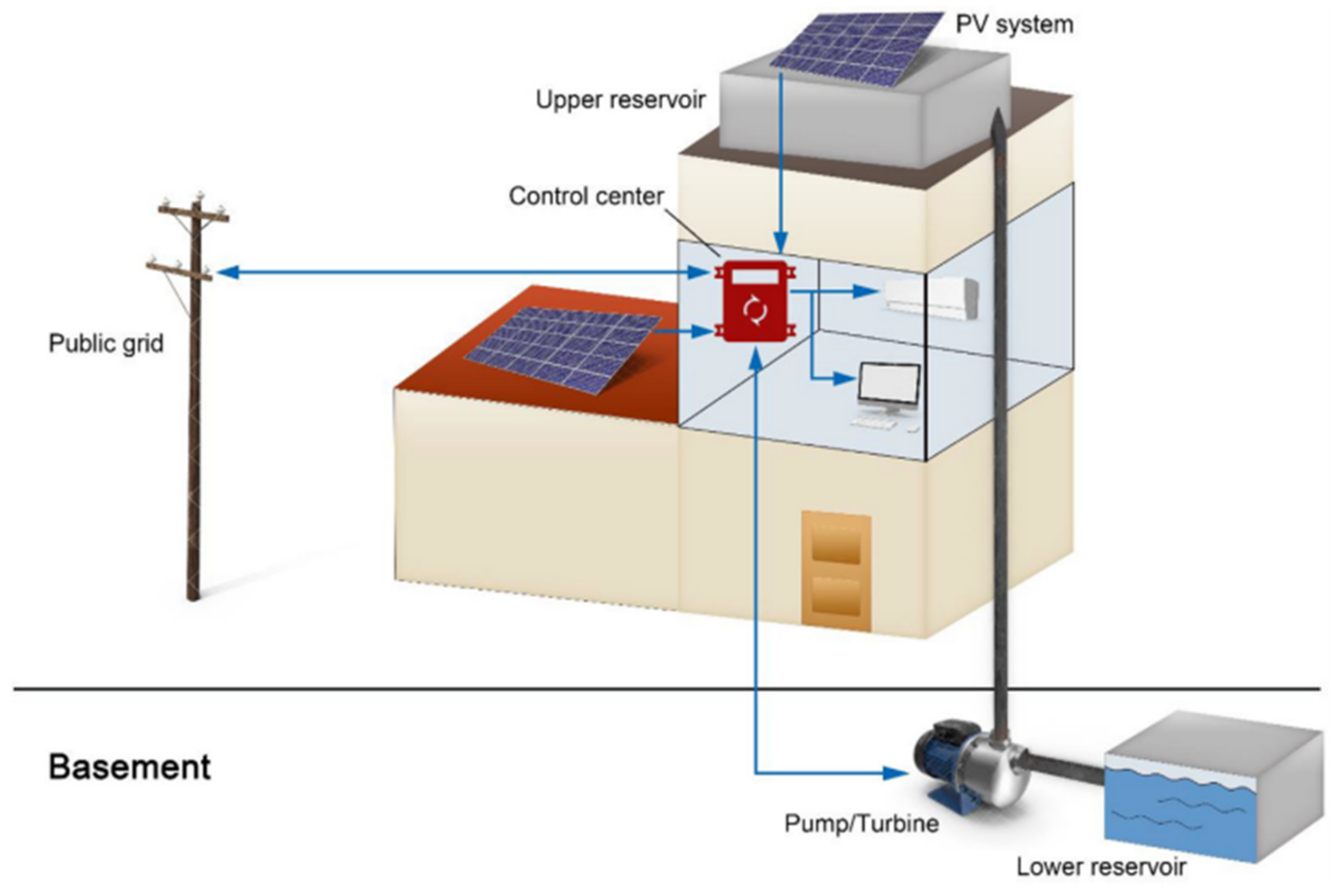
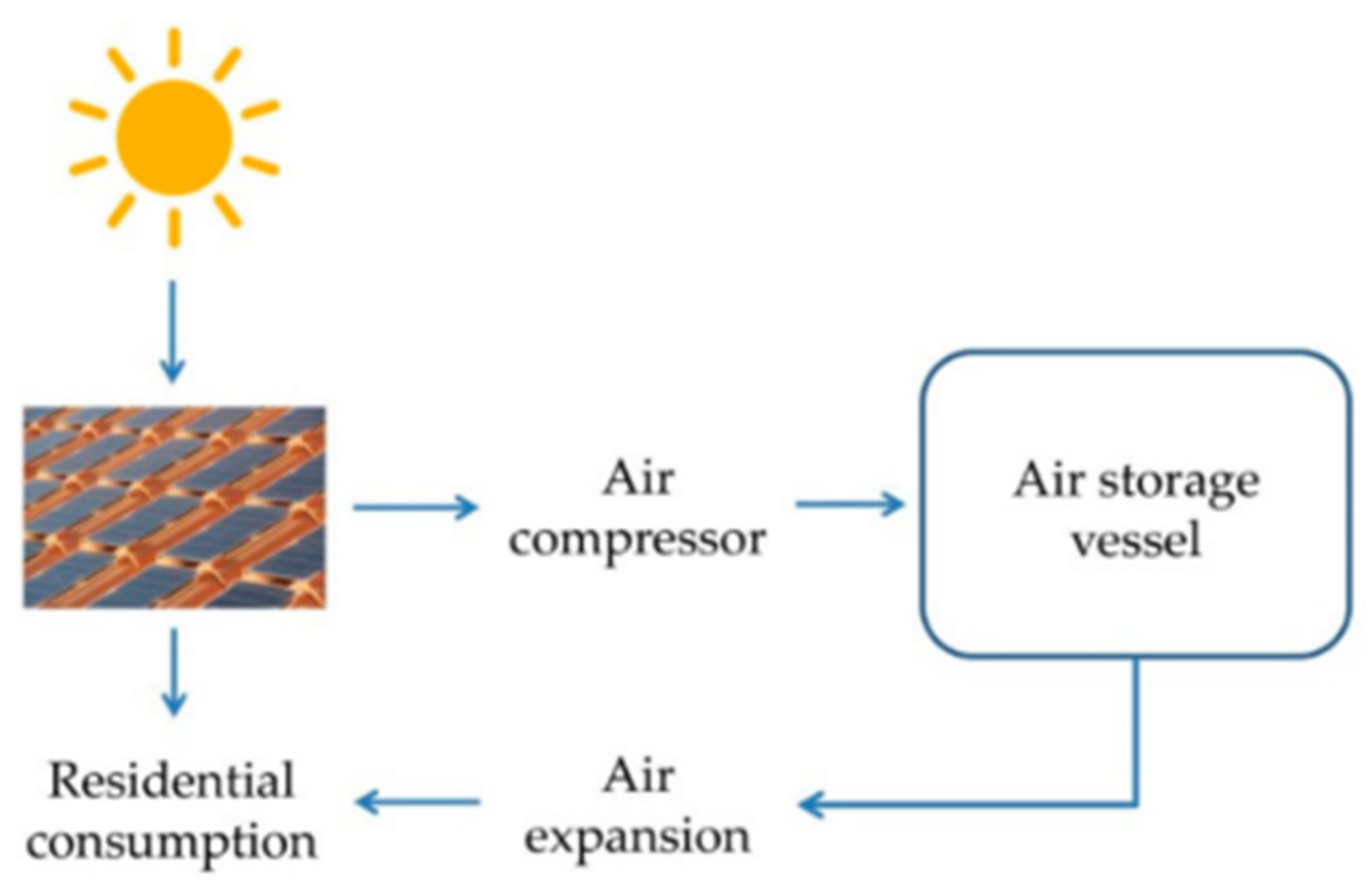
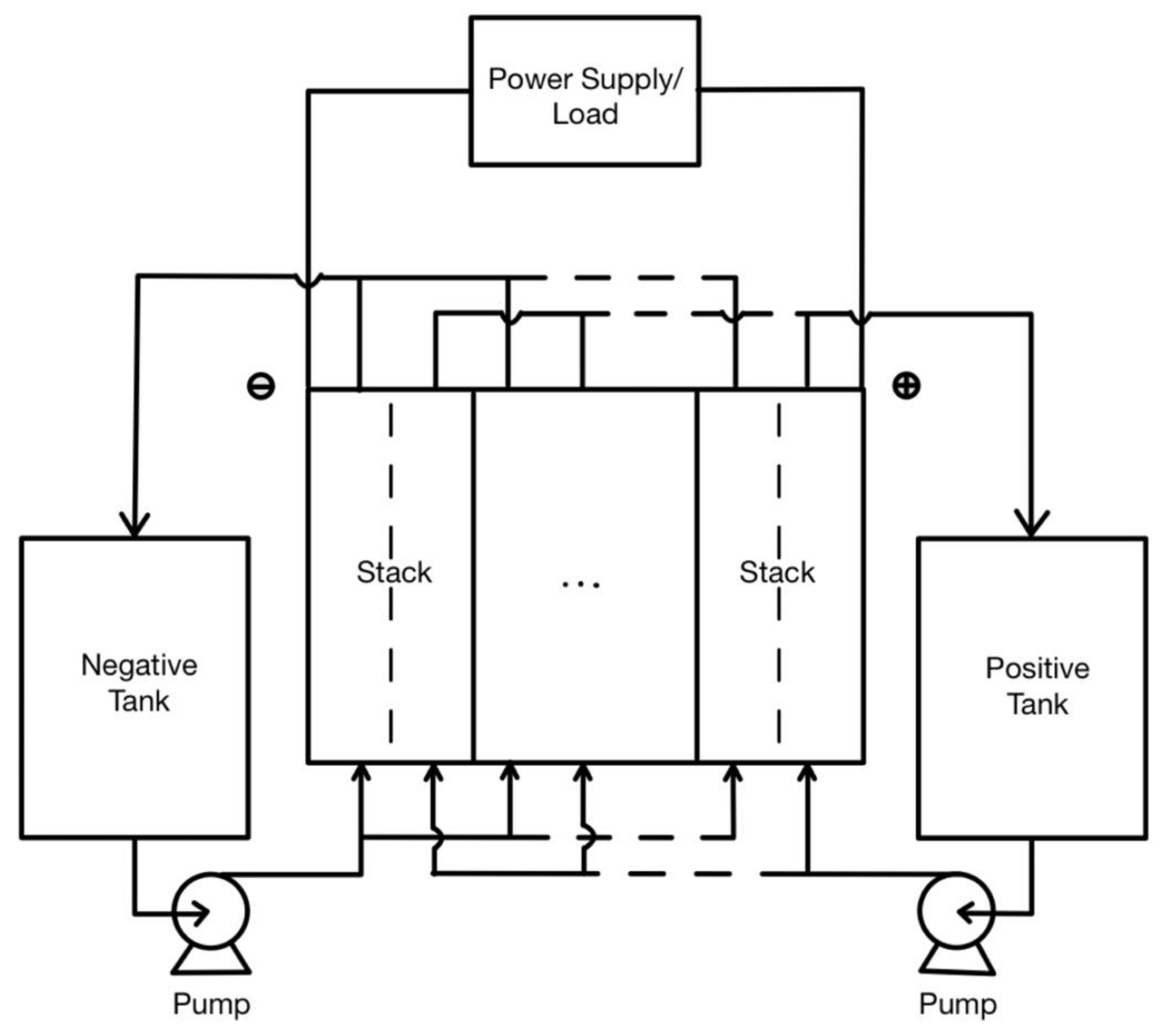
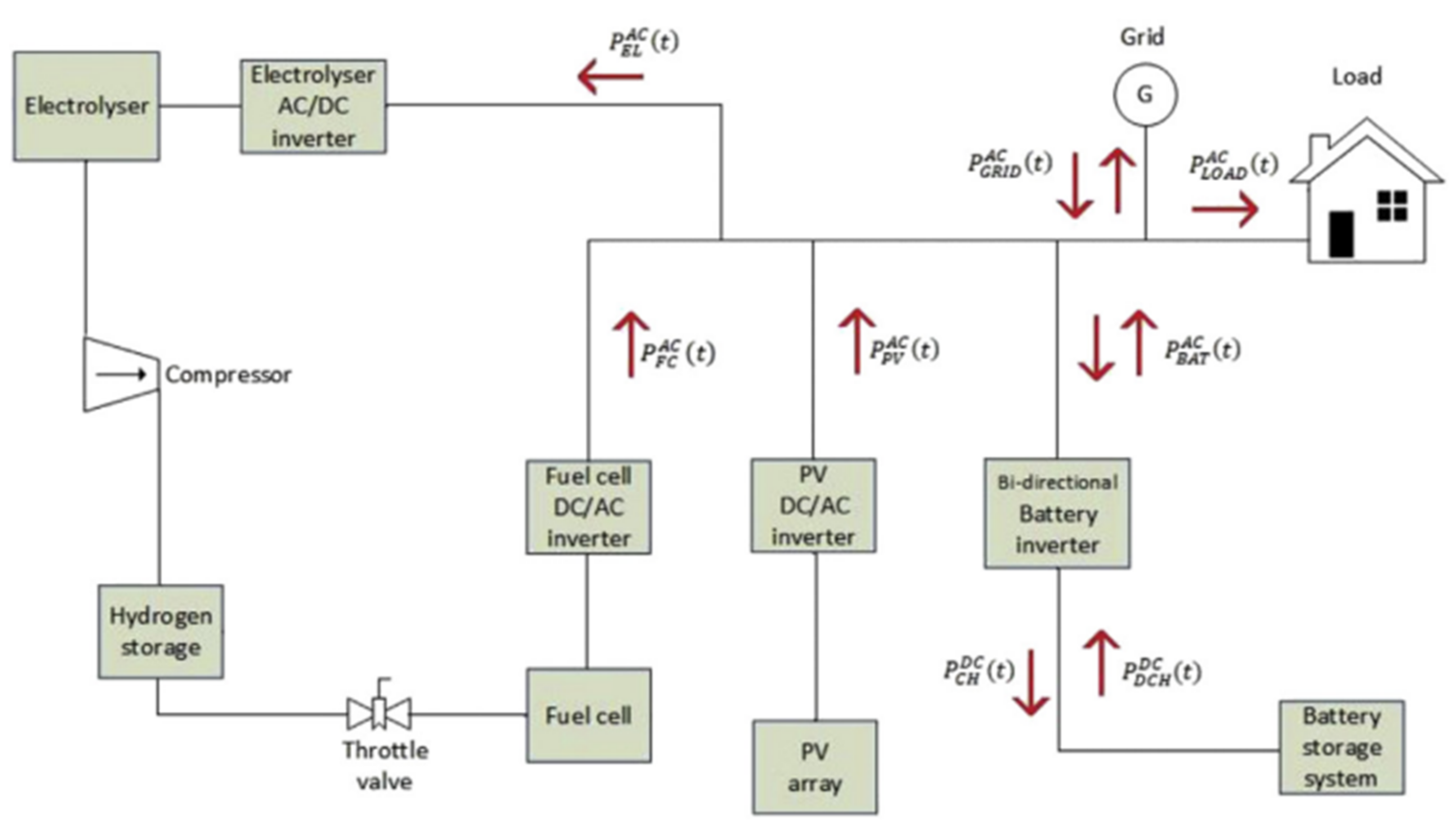
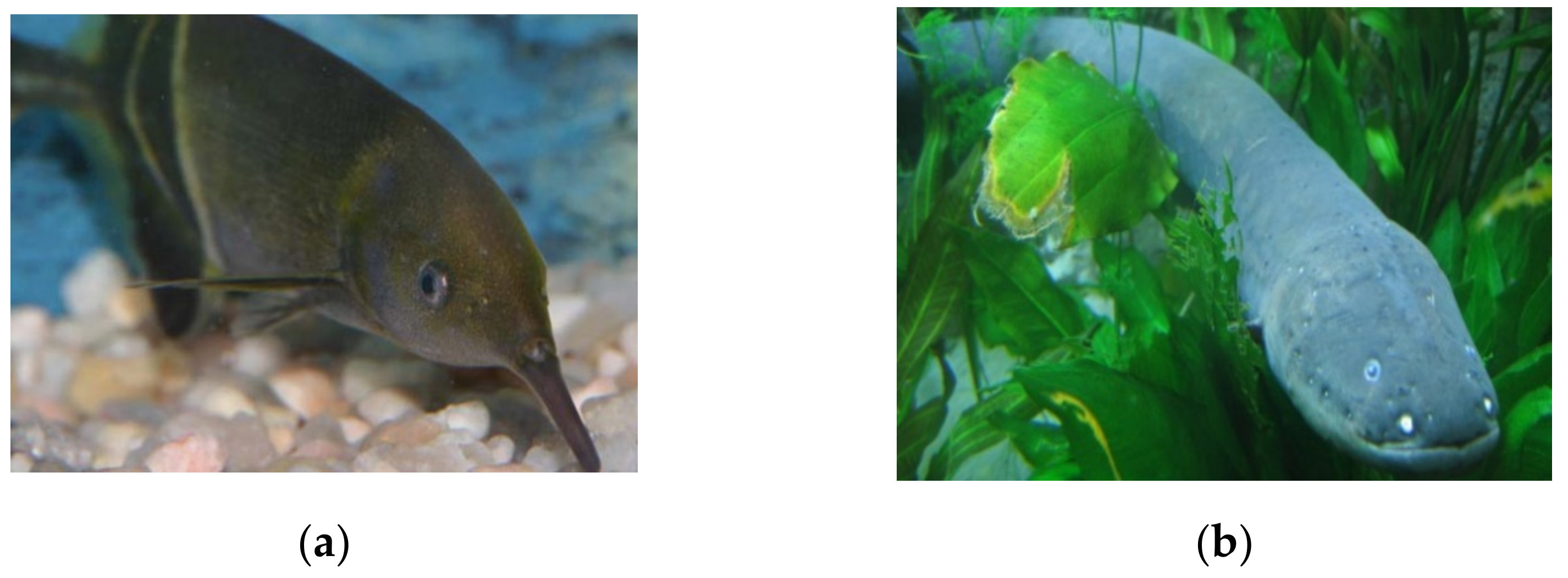
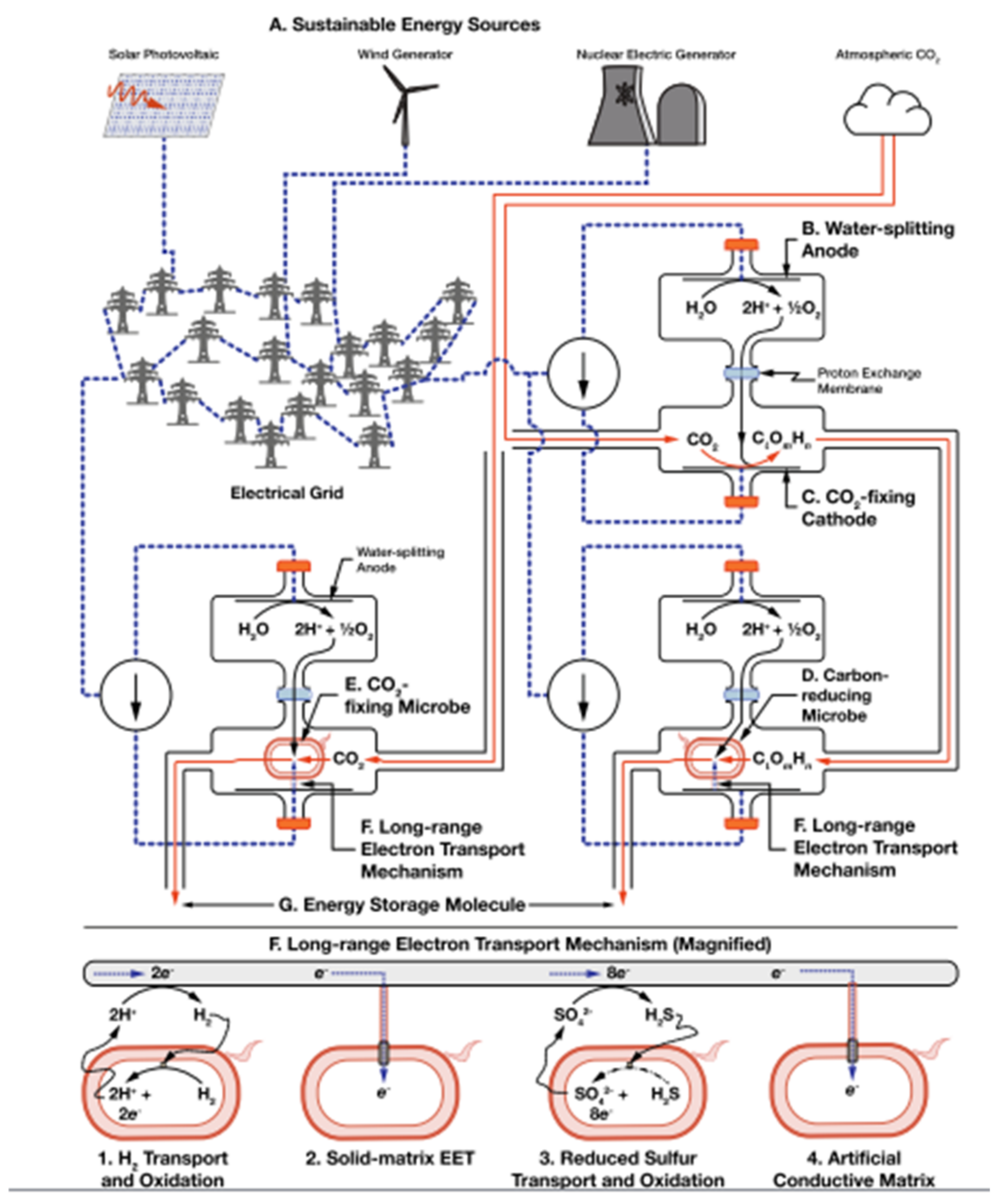


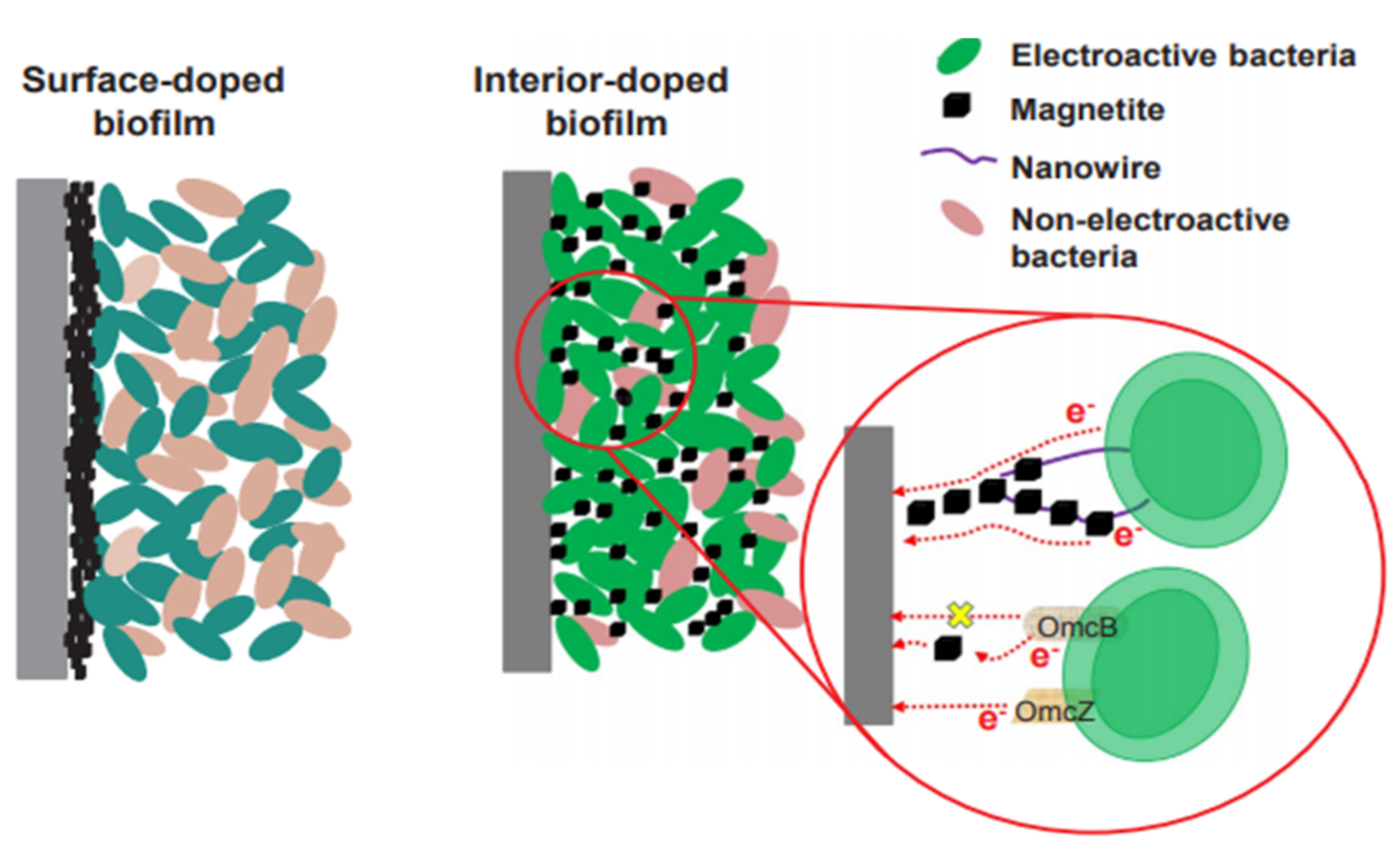
| Battery Type | Nominal Voltage (V) | Life Cicles (N° of Cicles) | Energy Density (Wh/kg) | Self-Discharge |
|---|---|---|---|---|
| Lithium-ion (Li-ion) | 3.6 | 500–1000 | 110–160 | Very low |
| Lead-acid | 2 | 200–300 | 30–50 | Low |
| Nickel-cadmium (Ni-Cd) | 1.25 | 1500 | 45–80 | Moderate |
| Nickel-metal hydride (Ni-MH) | 1.25 | 300–500 | 60–120 | High |
| Type | Description | Advantages | Disadvantages | Scale of Application | Storage or Generation Capacity | Efficiency | Reference |
|---|---|---|---|---|---|---|---|
| Hydro-pump | It has two reservoirs or basins connected through tunnels and wells through which water passes from an upper point to a lower one. Inside this system, turbines, pumps, and valves will generate the necessary electrical energy and control the water flow. |
|
| Buildings with photovoltaic installation for an apartment and villa building, Shanghai (China). | 5 kW for both cases (villa, apartment). |
| 2020 [1], 2018 [3], 2020 [14] |
| Compressed Air | The air is compressed and accumulated inside a subway reservoir as long as there is excess energy. Then, when an energy demand arises, the accumulated air expands into a turbine which generates electricity. |
|
| Residential building with photovoltaic system, Cittá di Castello (Italy). |
|
| 2020 [1], 2016 [4], 2018 [15] |
| Flywheel | The flywheel uses a rotating mass to store energy held in the rotor’s kinetic form. This kinetic energy is transferred in and out of the flywheel with the help of an electrical machine that acts as a generator or motor, depending on whether the system is in charging or discharging mode. |
|
| Buildings with photovoltaic installation (Germany). | N/D | 67% in the short term but decreases to 40% in the long term. | 2020 [1], 2018 [5], 2017 [6], 2016 [18] |
| Lithium Battery | Lithium batteries, including lithium-ion and lithium hydride batteries, represent the most popular battery type among consumer electronic devices due to their low weight, high energy density, and long cycle life. |
|
| Residential building with photovoltaic installation, Sweden. | 7 kWh | 85–95% | 2020 [1], 2018 [7], 2016 [16], 2016 [18] |
| Nickel Cadmium Battery |
|
|
| Commercial buildings, India. | 40 MW | 70–85% | 2020 [1], 2018 [7], 2017 [22] |
| Lead-Acid Battery | Their cells are based on the reaction between lead, lead oxide, and sulfuric acid. Their cells have a water-based liquid electrolyte that operates at room temperature. |
|
| Residential building with photovoltaic system, Cittá di Castello (Italy). | 4.6 kWh (total demand of the installation). | 70–80% | 2020 [1], 2017 [6], 2018 [7], 2018 [15] |
| Vanadium-Redox Battery | They consist of two electrolyte reservoirs where the electrolyte circulates through an electrochemical cell comprising a cathode, an anode, and a membrane separator. The energy density depends on the stored electrolyte volume and is independent of the electrochemical cell size and design. |
|
| Residences with photovoltaic installations (Australia) | 40–80 kW | 75–90% | 2020 [1], 2016 [15] |
| Supercapacitors | It consists of two metal plates separated by a small air gap. The amount of charge accumulated on each plate creates an electric field that balances the charge generated by the voltage. |
|
| Power Electronics | 8 kWh | 95% or higher | 2018 [8], 2020 [9] |
| Magnetic Superconduction | A large superconducting coil has almost no electrical resistance near absolute zero temperature and yet can store electrical energy within the magnetic field generated by direct current flowing through that field. |
|
| Grid-connected distributed generation structures. | 3 MW | 95% | 2020 [1], 2020 [10] |
| Hydrogen | It uses excess electricity produced by renewable sources to store it in the form of hydrogen, and when an energy demand arises, the reserved hydrogen is used as a fuel in the power plants. |
|
| Building with photovoltaic system (Slovenska Bristica, Slovenia). | N/D | 62.13% | 2020 [1], 2018, 2017, 2020 [11,12,13] |
Publisher’s Note: MDPI stays neutral with regard to jurisdictional claims in published maps and institutional affiliations. |
© 2021 by the authors. Licensee MDPI, Basel, Switzerland. This article is an open access article distributed under the terms and conditions of the Creative Commons Attribution (CC BY) license (https://creativecommons.org/licenses/by/4.0/).
Share and Cite
Dodón, A.; Quintero, V.; Chen Austin, M.; Mora, D. Bio-Inspired Electricity Storage Alternatives to Support Massive Demand-Side Energy Generation: A Review of Applications at Building Scale. Biomimetics 2021, 6, 51. https://doi.org/10.3390/biomimetics6030051
Dodón A, Quintero V, Chen Austin M, Mora D. Bio-Inspired Electricity Storage Alternatives to Support Massive Demand-Side Energy Generation: A Review of Applications at Building Scale. Biomimetics. 2021; 6(3):51. https://doi.org/10.3390/biomimetics6030051
Chicago/Turabian StyleDodón, Alisson, Vanessa Quintero, Miguel Chen Austin, and Dafni Mora. 2021. "Bio-Inspired Electricity Storage Alternatives to Support Massive Demand-Side Energy Generation: A Review of Applications at Building Scale" Biomimetics 6, no. 3: 51. https://doi.org/10.3390/biomimetics6030051
APA StyleDodón, A., Quintero, V., Chen Austin, M., & Mora, D. (2021). Bio-Inspired Electricity Storage Alternatives to Support Massive Demand-Side Energy Generation: A Review of Applications at Building Scale. Biomimetics, 6(3), 51. https://doi.org/10.3390/biomimetics6030051









